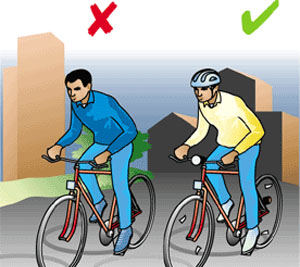Cyclists advised to wear a helmet
 Berlin - Cycling can be dangerous and riders should be aware that a crash or collision is possible anywhere - on the street, on a cycling path or in a race - and the cyclist isn't always the one at fault.
Berlin - Cycling can be dangerous and riders should be aware that a crash or collision is possible anywhere - on the street, on a cycling path or in a race - and the cyclist isn't always the one at fault.
Collisions and crashes can result in serious injuries, but helmets can help cyclists avoid injury to the head.
"A cycling helmet prevents up to 80 per cent of fractured skulls and brain haemorrhaging," said Professor Hans Zwipp of the German society for accident surgery in Berlin. Facial injuries can be prevented by a helmet only in part. The most dangerous injury is a brain haemorrhage, which can lead to death or cause paralysis.
"The most important argument in support of wearing a helmet when cycling is that if an accident occurs, riders wearing a helmet come away from them less injured," said Hannelore Herlan of Germany's traffic watch centre in Berlin. However, there also are studies showing that cyclists who wear helmets ride more aggressively and therefore experience more accidents, said Andre Glaeser of a nationwide German cycling club.
In Germany the decision to wear a helmet or not is left to the cyclist. There is no legal requirement that a cyclist wear one. The cycling club does not consider this unwise, pointing out that when other countries - Australia, for example - implemented a helmet law, the number of cyclists declined drastically. Aside from that there is no guarantee that a cyclists wearing a helmet won't sustain an injury in an accident.
"You can't say that if you are wearing a helmet you will survive an accident," said Glaeser.
The traffic centre believes it is more sensible to convince people to wear helmets based on safety arguments than to legally require them to wear one. Helmet law also is hard to enforce and police would have their hands full if one were introduced. Herlan said the voluntary approach is working as more cyclists use a helmet even though there is not a helmet law.
"Many parents set a good example and most children wear a helmet," said Herlan.
Helmets are especially important for children, who have accidents more often than adults due to their inexperience, said Welf Stankowitz of Germany's traffic safety council in Bonn. However, adults are bigger and their bicycles are larger, making the distance to the ground greater, and their reflexes also are slower. Thus, a helmet is equally as important for them and they should wear one, said Stankowitz.
"The helmet is to a cyclist what a seatbelt is to someone driving or riding in a car," he added.
A helmet should have a seal of approval, showing it meets EU safety standards. Consumers can be sure that helmets that have the seal have been made from good material and that the material has been tested, the traffic watch centre said.
A further criteria of a quality helmet is its shape. There are different styles, but the helmet should always fit the cyclist's head and the strap under the chin should be comfortable and easy to adjust. The helmet should have relatively large openings throughout to allow ventilation so that the cyclist's head doesn't sweat. If the helmet meets those criteria and can be put on and removed quickly, then it is the right one.
Helmut Loetzerich of Germany's cycling sport school in Cologne said once-popular helmets made of styrofoam are best avoided. The material blocks the impact of the head against asphalt, but the result is neck injury.
Loetzerich considers himself a role model for cyclists and wears a helmet every time he rides.
"In the meantime helmet use has become a requirement in all races - professional and amateur," he said. Wearing a helmet regularly can't hurt, he reckons. "A crash on a sturdy town bike can be just as dangerous as a crash in a bicycle race." (dpa)